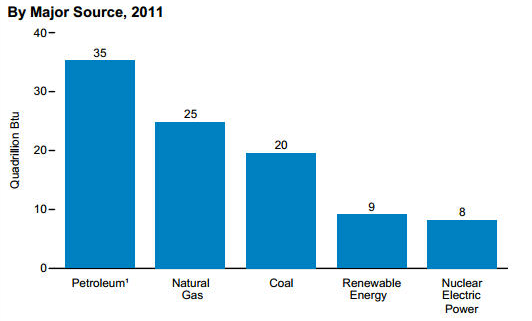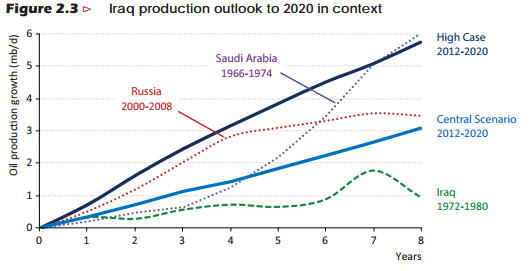The IEA’s 2012 World Energy Outlook has spurned many a headline since its release on Monday, which should be none too surprising given it is 688 pages long. The executive summary of the report can be viewed here (which is 676 pages less than the full version), while through even more distillation here are ten points I have gleaned from it in the past few days:
1) The number of vehicles on the road is set to double to 1.7 billion by 2035. Increasing demand for road freight is responsible for almost 40% of the increase in global oil demand.
2) U.S. oil production is set to surpass that of Saudi Arabia by 2020 to become the largest global oil producer (caveat: this will only likely be until the mid-2020s, when Saudi takes back this accolade)
3) Natural gas is set to become the most widely-used fuel in the U.S. by 2030. Here is the current breakdown, courtesy of the EIA’s 2011 Annual Energy Review:
4) Renewable energy is to soar by 2035, accounting for almost one third of total electricity output. Renewables are set to become the second-largest source of power generation in 2015, led by hydropower, and are set to approach a similar level to coal (= the largest source) by 2035. There will be 26 times more generation from solar power by 2035, but it will still only account for 2% of total generation
5) Iraq is to make the largest contribution to global oil supply growth as oil output exceeds 6 mbpd in 2020, rising to above 8 mbpd in 2035. China is set to be the biggest beneficiary of this increase, becoming their main buyer by 2030, while Iraq becomes the second largest global oil exporter, surpassing Russia. This report on Iraq from the IEA last month shows its oil growth projection put in context:
6) Global fossil fuel subsidies increased 30% in 2011 to $523 billion. Global fossil fuel subsidies are six times greater than those for renewables (at $88 billon)
7) Nearly three-quarters of projected non-OECD coal demand growth comes from China and India, with India surpassing the U.S. by 2025 as the world’s second largest user of coal (behind China), while becoming the largest importer of coal by 2020. OECD demand for coal is expected to decline going forward
8) Water shortages are the key constraint on power and energy. Piggy-backing on last week’s burrito post about China’s water scarcity comes this nifty chart from the IEA, highlighting the vulnerability of various regions. 23% of China’s water is consumed by industry, most of which is involved in coal production. The chart below shows coal producers in relation to water vulnerability:
9) The U.S. is predicted to become a net exporter of oil by 2035, although there is a good amount of skepticism surrounding this prediction. (and some general scoffing by peak oil theorists)
10) Global energy demand is set to grow by a third by 2035, with China, India, and the Middle East accounting for 60% of the increase. Energy demand in the developed countries (=OECD) barley rises.
I hope these points were useful. I would like to close, however, with a word of caution: that these are merely projections, and should be used as reference points and to identify trends, rather than for hard and fast targets. As one analyst has said in the aftermath of the report, beware!
- English (UK)
- English (India)
- English (Canada)
- English (Australia)
- English (South Africa)
- English (Philippines)
- English (Nigeria)
- Deutsch
- Español (España)
- Español (México)
- Français
- Italiano
- Nederlands
- Português (Portugal)
- Polski
- Português (Brasil)
- Русский
- Türkçe
- العربية
- Ελληνικά
- Svenska
- Suomi
- עברית
- 日本語
- 한국어
- 简体中文
- 繁體中文
- Bahasa Indonesia
- Bahasa Melayu
- ไทย
- Tiếng Việt
- हिंदी
Projections Proffered By The IEA
Published 11/15/2012, 01:46 PM
Updated 07/09/2023, 06:32 AM
Projections Proffered By The IEA
3rd party Ad. Not an offer or recommendation by Investing.com. See disclosure here or
remove ads
.
Latest comments
Install Our App
Risk Disclosure: Trading in financial instruments and/or cryptocurrencies involves high risks including the risk of losing some, or all, of your investment amount, and may not be suitable for all investors. Prices of cryptocurrencies are extremely volatile and may be affected by external factors such as financial, regulatory or political events. Trading on margin increases the financial risks.
Before deciding to trade in financial instrument or cryptocurrencies you should be fully informed of the risks and costs associated with trading the financial markets, carefully consider your investment objectives, level of experience, and risk appetite, and seek professional advice where needed.
Fusion Media would like to remind you that the data contained in this website is not necessarily real-time nor accurate. The data and prices on the website are not necessarily provided by any market or exchange, but may be provided by market makers, and so prices may not be accurate and may differ from the actual price at any given market, meaning prices are indicative and not appropriate for trading purposes. Fusion Media and any provider of the data contained in this website will not accept liability for any loss or damage as a result of your trading, or your reliance on the information contained within this website.
It is prohibited to use, store, reproduce, display, modify, transmit or distribute the data contained in this website without the explicit prior written permission of Fusion Media and/or the data provider. All intellectual property rights are reserved by the providers and/or the exchange providing the data contained in this website.
Fusion Media may be compensated by the advertisers that appear on the website, based on your interaction with the advertisements or advertisers.
Before deciding to trade in financial instrument or cryptocurrencies you should be fully informed of the risks and costs associated with trading the financial markets, carefully consider your investment objectives, level of experience, and risk appetite, and seek professional advice where needed.
Fusion Media would like to remind you that the data contained in this website is not necessarily real-time nor accurate. The data and prices on the website are not necessarily provided by any market or exchange, but may be provided by market makers, and so prices may not be accurate and may differ from the actual price at any given market, meaning prices are indicative and not appropriate for trading purposes. Fusion Media and any provider of the data contained in this website will not accept liability for any loss or damage as a result of your trading, or your reliance on the information contained within this website.
It is prohibited to use, store, reproduce, display, modify, transmit or distribute the data contained in this website without the explicit prior written permission of Fusion Media and/or the data provider. All intellectual property rights are reserved by the providers and/or the exchange providing the data contained in this website.
Fusion Media may be compensated by the advertisers that appear on the website, based on your interaction with the advertisements or advertisers.
© 2007-2024 - Fusion Media Limited. All Rights Reserved.
